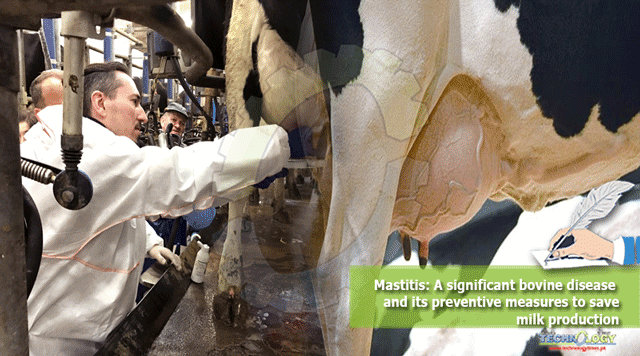Bovine mastitis is the persistent inflammation of udder due to microorganisms, physical injury, or trauma.

Author: Dr.Maria Jamil1, Dr.Ali Raza2, Dr.Muhammad Tahir Aleem3
Bovine mastitis:
Bovine mastitis is the persistent inflammation of udder due to microorganisms, physical injury, or trauma. Mastitis is the potentially lethal and most common infection of the mammary gland in dairy cattle. Toxins produced by bacteria damage the mammary gland leads to a decrease in milk quality and yield. This infection can also be recognized by defects in udder such as swelling, redness, hardness, hot, and pain in the udder. Other signs included the watery appearance of milk and the presence of flakes and clots in milk. Bovine mastitis in the case of subclinical mastitis cow not shown any sign and symptom in milk and udder. For the dairy industry, mastitis is a very expensive disease. Somatic cell count in cow’s milk is very high that is suffering from mastitis. After milking, mastitis may occur because teat holes close after 15 minutes if the animal sits in a dirty place with feces and urine.
Cause of mastitis:
In dairy cow staphylococcus aureus is one of the main causative agents of mastitis. Mainly infection is caused by several species of staphylococci, streptococci, and gram-negative rods especially enteric region of lactose fermenting organism known as coliform bacteria. Infection may be contagious or environmental (E.coli). Only mycoplasma species which may transmit cow to cow by aerosol. During milking, the contagious transmission of the pathogen may occur through milker’s hands. Streptococcus agalactiae, staphylococcus aureus, and corynebacterium bovis are contagious bacteria.
Factor influencing the occurrence of mastitis:
Type of mastitis:
Clinical mastitis
Subclinical mastitis
Per acute mastitis
Acute mastitis
Sub-acute mastitis
Chronic mastitis
Transmission Mode:
- Contagious
- Environmental
- Oral to udder among calves
- Contaminated materials (hands, and milking machine)
Effects on milk composition:
Mastitis may cause to enhance the lactoferrin and reduced the potassium and milk protein (casein) level in milk. As calcium level in milk is linked with casein. During processing and storage, casein is continuously declining. Somatic cell count is high in mastitis milk by this quality, and the quantity of milk is decline.
Detection of mastitis:
California mastitis test is used for the detection of mastitis for this test using a plastic paddle. 3% surf solution is used equal quantity of surf and milk is added in plastic paddle from each teat, and if agglutination occurs, then the test is positive.
Cattle affected by mastitis may be confirmed by inspecting the udder for any swelling and inflammation also by detecting the consistency of milk, presence of any clot, or change in color.
Treatment:
- Penicillin injection in combination with sulpha drug
- Intramammary therapy: Intramammory products which contain penicillin, amoxicillin or cephalosporins
- Vaccination for mastitis is also available
Prevention and Control:
- Reducing heat stress
- Cleaning and disinfection
- Removal of udder hair
- Avoiding teat trauma
- In parturient cows decreased the udder edema by nutritional management of sodium and potassium
- Prevent the accumulation of water
- For proper lying behavior maintain the salt
- Avoiding the fly exposure
- Proper milking procedure and separation of infected cows
- Pre-milking teat dips or spray such as iodine spray
- Post milking use iodine propylene glycol as a disinfectant
- Department of Pathology, Faculty of veterinary science, University of Agriculture, Faisalabad
- Department of Microbiology, Faculty of veterinary science, University of Agriculture, Faisalabad
- MOE Joint International Research Laboratory of Animal Health and Food Safety, College of Veterinary Medicine, Nanjing Agricultural University, 210095 Nanjing, P.R.China
Author: Dr.Maria Jamil1, Dr.Ali Raza2, Dr.Muhammad Tahir Aleem3
